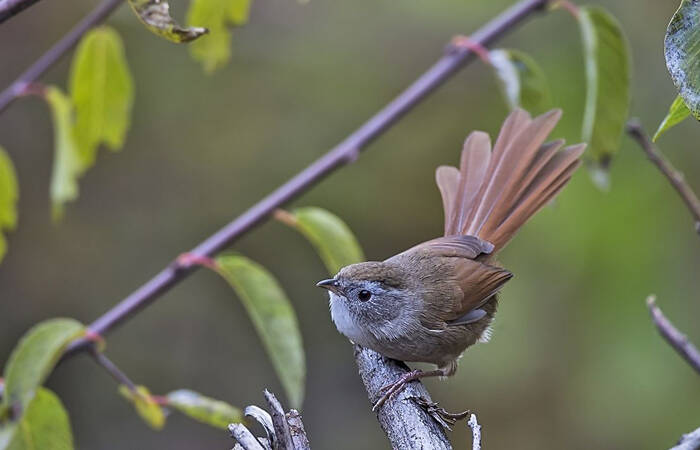Moupinia poecilotis
IUCN
LCBasic Information
Scientific classification
- name:Moupinia poecilotis
- Scientific Name:Rufous-tailed Babbler,Moupinia poecilotis,Chrysomma poecilotis,Baoxing owl, brown-tailed owl, stone-painted eyebrows
- Outline:Songbird
- Family:Passeriformes Ornithogalidae Babbler
Vital signs
- length:13-15cm
- Weight:About 13g
- lifetime:No verification information
Feature
Active and likes to jump around in the undergrowth.
Distribution and Habitat
The Baoxing Babbler is a bird endemic to China. It is distributed in Pingwu, Ma'erkang in northern Sichuan, Emei, Tianquan, Baoxing, Emeishan, Ebian, Pengxian in central Sichuan, Luding, Kangding, Yajiang in the west, Muli in the southwest, Meigu and Ganluo in the south, and Lijiang and Zhongdian in northwestern Yunnan.
Appearance
The plumage of males and females is similar, with olive brown from forehead to top of head, hard feather shaft of forehead, soft feather shaft of top of head, nearly white at forehead base and eye, black feather tip in mottled shape; eyebrow pattern is gray or off-white, slightly stained with light brown or tea yellow, cheek and ear feathers are brown or light olive brown, some are stained with brown, all feathers have white feather shaft pattern, and the neck is light olive brown. The back and shoulders are light olive brown or olive green brown, the lower back and waist are olive green brown and sometimes slightly stained with brown. The upper tail coverts are more brown, often brown-green, the tail feathers are almost pure brown-red, the surface of the two wings is brown or brown chestnut, the flight feathers are dark brown, the upper wing coverts are the same color as the upper back; the large coverts are slightly stained with brown. The chin, throat, chest and middle abdomen are g
Details
Baoxing Babbler, also known as Rufous-tailed Babbler in English, is a small bird of the Warbler family and the genus Babbler, with no subspecies.

The similar species of Baoxing Babbler, the Golden-eyed Babbler (Chrysomma sinense), has exposed nostrils, a brown head and upper body, white eyes and lower cheeks, orange-yellow feet, and a larger body. It is not difficult to distinguish it both in the wild and indoors.
Baoxing Babbler is a resident bird. It mainly inhabits various vegetation types at different altitudes, such as subtropical green broad-leaved forests, coniferous broad-leaved mixed forests, coniferous forests, alpine shrubs, and meadows at an altitude of 1500-3700 meters in Sichuan and northwest Yunnan, China. It moves in pairs or small groups. It is lively and often jumps between the undergrowth, and occasionally makes "ju-ju-ju" or "ji-ji" calls.
Baoxing Babbler mainly feeds on insects. According to 32 bird stomachs dissected by Li Guiyuan et al. (1985) in Sichuan, China, the food is mainly insects and insect larvae of Coleoptera, Lepidoptera, Hymenoptera, etc., and occasionally eats a small amount of other invertebrates such as spiders and plant fruits and seeds.
The breeding season of Baoxing Babbler is from May to July. It usually nests in the understory of mountain forests at an altitude of 1500-3000 meters. According to a nest found by Li Guiyuan et al. (1985) at an altitude of 1700 meters, the nest is cup-shaped and built on a low tree, about 0.33 meters above the ground. The nest is mainly composed of grass leaves, grass stems and a small amount of bark, with wool and grass stems as padding. The size of the nest is 7.5 cm in outer diameter, 5 cm in inner diameter, 7 cm in height and 5 cm in depth. There are 3 eggs in the nest, which are white in color and covered with ochre, purple-brown or light brown-white spots of varying sizes and shapes, especially denser at the blunt end. The size of the eggs is 18-18.6 mm × 14 mm according to the measurement of 3 eggs, and weighs about 1.7 grams.
Listed in the "Red List of Threatened Species of the World Conservation Union" (IUCN 2016 ver 3.1) - Least Concern (LC).
Listed in the "National List of Terrestrial Wildlife with Important Economic and Scientific Research Value" issued by the State Forestry Administration of China on August 1, 2000.
Has been listed in the "Global Endangered Bird List" by Bird Life International.
Listed in the second level of the "National Key Protected Wildlife List of China".
Protect wild animals and stop eating game.
Maintaining ecological balance is everyone's responsibility!








